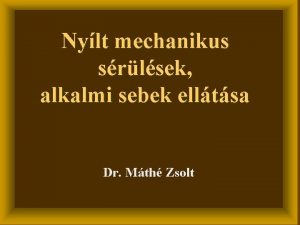LATE COMPLICATIONS AFTER OSTEOSYNTHESIS WITH VOLAR LOCKING PLATE

- Slides: 1

LATE COMPLICATIONS AFTER OSTEOSYNTHESIS WITH VOLAR LOCKING PLATE FOR DISTAL RADIUS FRACTURES Obada B. , Serban Al. , Borgazi E. , Badauta M. , Botnaru V. , Bajenescu T. Orthopaedic-Traumatology Clinic of Constanta, Romania AIM In literature is an increasing tendency for open reduction and internal fixation with volar locking plate for the treatment of distal radius fractures. The aim of the study was to evaluate the late complications of this method, to identify and estimate the incidence of these complications and to identify which type of fracture associated with more complications. MATERIAL. METHODS. Our retrospective study was made between 2010 and 2014 and consist of a group of 255 patients with distal radius fracture treated with volar locking plate in our department. There were 93 men and 162 women. The age was between 21 -75 years and 67% were right hand fractures. We used for the evaluation of the patients the AO classification: 76 type A, 50 type B and 129 type C. SIDE SEX AGE 8% 64% 36% 33% Women Men 16 -30 years 31% 67% Right 61% Left 31 -60 years > 61 years RESULTS The late complications we met were: tendon injuries 7. 2%, median nerve compression 6. 8%, problems related to implant 5. 3%, neuroalgodistrophy 3. 2% and loss of articular reduction 5. 3%. 129 140 120 100 80 60 40 20 0 76 50 Type A Type B Type C AO classification 18 18 16 14 12 10 8 6 4 2 0 17 Tendon injuries 13 13 8 Median nerve compression Problems related to implant Neuroalgodistrophy Loss of reduction Complications DISCUSIONS Flexor tendon ruptures have been reported more frequently as a complication of volar plating. Median nerve dysfunction could be attributed to traction on the nerve during the volar approach to the radius. There was a correlation between surgeon experience and complication rate. Loss of fixation in volar plating of distal radius fractures, seems to be rare and may be related with improper indication or imperfect reduction. CONCLUSIONS The complication rate decreased with increasing surgeon experience, suggesting that many of these complications can be avoided. Accurate placement of the plate and exact measurement of the screws may minimize the incidence of complications. The complication rate we found make us to improve the informed consense we make before surgery to the patient and to improve and correct the surgical technique applied.

